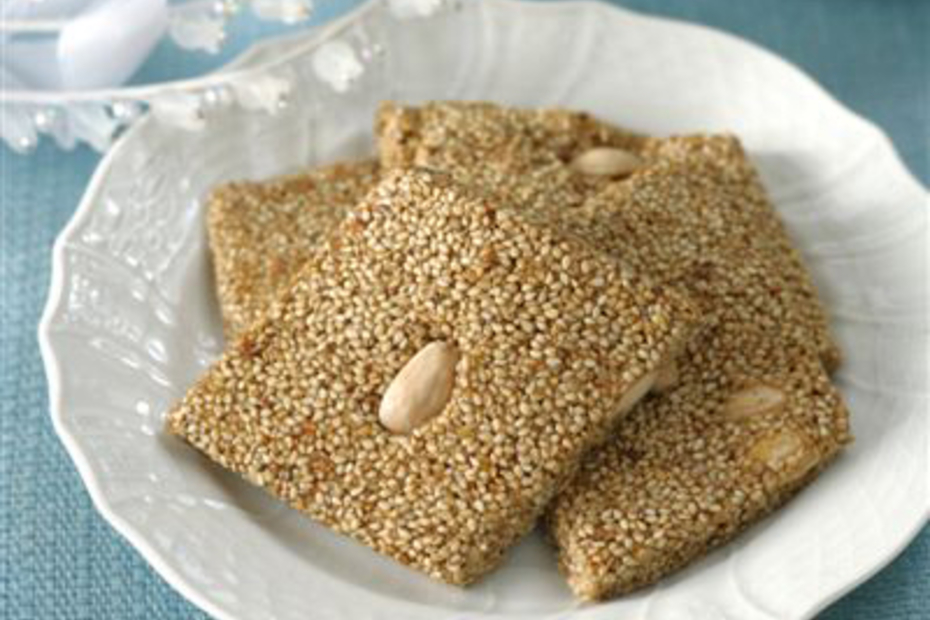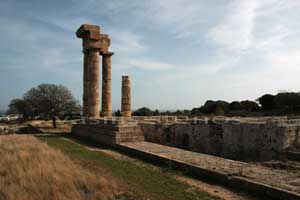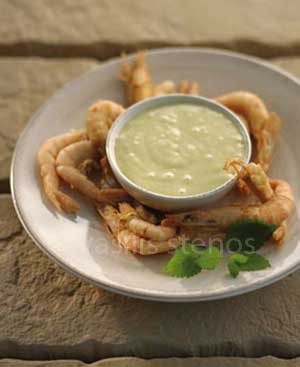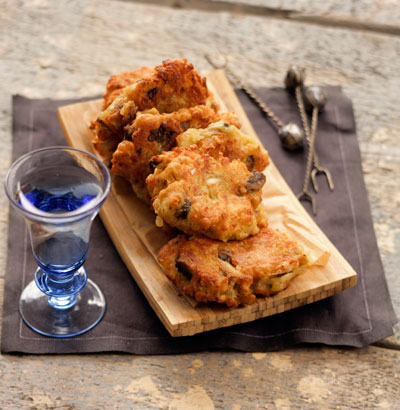When I set out to search the foodlore of the Dodecanese, I thought I would find unique and wholly separate customs from island to island. But all the Aegean islands share a terse, pared down cuisine that long ago became the norm of poor sea-bound people in this part of the world. There was always a certain fluctuation and mobility among local populations in the Aegean, with people moving from island to island to work and live. Life’s needs aren’t that different from one parcel of sea-bound rock to another, so it stands to reason that the cuisine to emerge from the north to the south of the Aegean be relatively uniform. Hence, many dishes found in the Dodecanese are also found in the rest of the Aegean. Things such as the stuffed Paschal lamb–almost every Aegean island has its own rendition of this dish–festive wheat and meat dishes (found especially in the eastern Aegean islands, from Lesvos to Rhodes), skillet fish “pies” made with small fry and flour, a wealth of beans and legumes as well as simply prepared fish are leitmotives in the cuisine throughout the whole region and are not specific to the Dodecanese.
What is perhaps different here is the frequent use of certain spices, such as cumin, which one also finds readily in the cuisine of nearby eastern Crete. Another shared characteristic with the Cretan kitchen–there are many–is the plethora of barley rusks that are a basic part of the table here. Sesame seeds and sesame paste (tahini) play a greater role in the Dodecanses than elsewhere in the Aegean, perhaps owing to these islanders’ continual contact with Egypt. There are also a number of dishes found in the Dodecanese that are almost identical to those found in Cyprus, which is also close and with which there has always been frequent contact.
When one looks at the cuisine here, it becomes obvious that Dodecanese cooking, like all Greek cooking, is a combination of influences: Strictly local needs and landscapes–i.e., whether an island’s livelihood was dependent on the sea, as in Kalymnos, Simi and Chalki, or turned inland to the mountains, as in Rhodes and Karpathos–combined with the inevitable stamp that proximity to Asia Minor and Africa, but also to Crete and Cyprus was bound to impress upon the local populations, forge the characteristics of the Dodecanese kitchen.
The Sea
The people of Simi, a tiny, arid island not too far from Rhodes, have a nickname. Their big neighbors across the way sometimes call them, jokingly, sardelotzoumia–sardine juice–because of the large amounts of dried fish these veteran fishermen are known to consume. For the islands of the Aegean where the sea provided men’s livelihoods from time immemorial, its bounty is aptly represented on the table, too. Simi and Kalymnos, the island most famous for its sponge fishermen, lay claim to the greatest wealth of seafood dishes among the Dodecanese.
In these islands, for example, one encounters some of the most unusual preserved seafood in all of Greece. The sponge fishermen would leave their homes just after Easter and not return again until the Fall. They needed a supply of food for their long months at sea, and, as a result perfected the art of preserving fish and seafood. Although the sponge industry has all but died among these islanders, their eating habits have remained intact, and many of their foods of sustenance have now come to be local delicacies. Fishermen in Simi, for example, have a special hankering for sun-dried picarel, which they string and hang to dry for several days. The parrotfish, scaros in Greek, especially esteemed throughout all the Dodecanese, is also salted and dried in Simi. This fish has an unusual reputation among Greek gourmets–it is best savored together with its intestines. In Simi, the fish as well as the intestines are dried, separately, and enjoyed as meze.
The sponge fishermen are known to have been avid lobstermen, too, and one local delicacy, in both Simi and Kalymnos, is sun-dried lobster tail, which was eaten during Lent. In fact, this is a delicacy savored among many Aegean fishermen–I found the dish in Limnos, too. Sun-dried octopus is another local specialty, and there were two ways to do this. The first, called melihlora, was considered superior. The octopus is left to dry in the sun and sea air for just a few days, then is doused with pepper, which acts as a preservative. Fully dried, dehydrated octopus are also savored in these parts during the great pre-Easter fast. One odd but esteemed meze is a local version of botargo, but made octopus roe. The fishermen prefer the eggs of large octopus, which could weigh up to two pounds. They air-dry them slowly, over about a month, then savor the dried eggs either raw or grilled over charcoal. Local fishermen also make a delicacy out of the octopus’ ink, frying it with olive oil, salt and pepper.
The litany of unusual seafood delicacies doesn’t end there. Surely, the most unusual of the fishermen’s preserved-seafood larder is the array of various shellfish put up in seawater. The best known (locally, that is), is the spinialo, made with either fan mussels, sea urchins or sea-skirts (in Alan Davidson’s words, “A knobbly creature with a leathery skin which lives anchored to rocks and is so constructed as to permit the sea water to pass through it. Its yellow flesh, like scrambled eggs, is considered a delicacy in Provence). Simi fishermen add snails to their list of seawater-brined fish, too. The creatures, once cleaned and salted, are preserved in sea water, and usually kept, for economy’s sake, in old retsina bottles. Sponge fishermen would take along supply of spinialo with them to sea, and eat them together with one or another type of barley rusk and some olive oil and lemon. The spinialo is an acquired taste, to be sure, redolent of iodine but delicious.
Simi and Kalymnos both have some other great seafood dishes to their credit, too. I found some of the most delicious octopus recipes I’d encountered anywhere, from an ouzo-dipped grilled octopus to ground up octopus turned into succulent patties. In Simi, during Lent, octopus is ground up like hamburger meat and cooked in a sauce for pasta.
In local waters, there are some regional species of fish and seafood, too. Islanders, especially in Rhodes and Kos, hold a relative of the red mullet, which they call rozeti, in very high esteem. Simi is well-known for its tiny shrimp, which are usually served up fried. In Karpathos, the parrotfish is beloved and is said to be especially good when fished from nearby waters.
By and large, though, the fish cookery follows the examples of fish cookery everywhere in the Aegean. The recipes tend to be simple, and little belongs specifically or exclusively to one place.
The Land
The same pretty much holds true regarding the pastoral and farming traditions in the Dodecanese. Granted, some islands, such as Rhodes, are much more fertile than others, but by and large the fruits of the land are the same from island to island, not only among the Dodecanese, but among most of the Aegean islands. The traditional diet here boasts a host of dishes based on bread and grains, with bulgur and cracked wheat claiming a prominent place. Islanders throughout the most of the Dodecanese make a delicious dish of home-made pasta with caramelized onions. It is so much a part of the local palate that even tavernas serve it. There are also many old dishes, both sweet and savory, based on flour–cream-like dishes akin to polenta that were simple, cheap and filling, and could sate the hunger of hard-working shepherds and their families. Most of these dishes–things such as the stale crusts of country bread cooked in milk, pasta or bulgur wheat cooked in milk, and much more, people abandoned long ago, for these dishes came to be associated with the dire poverty that marked most of these islands before tourists discovered them.
Staples like the yellow chick pea–in some places, such as Nyssiros, so much a food of sustenance that the word in the local dialect, maerema, was synonymous with cooking itself; fresh and dried black-eyed peas; chick peas prepared a dozen different ways; wild greens not unlike those found in Crete; and myriad dry barley rusks–in these parts most often spiced–still make up the typical Dodecanese larder.
The chick pea, in fact, is something of a national dish, and appears most frequently in the form of fried patties, especially in Rhodes, Kos and Nyssiros. Sesame seeds and tahini are used more here (especially in Rhodes) than anywhere else in Greece, perhaps owing to the constant exhange between the islands and Egypt. Tahini breads and pies, like those found in Cyprus, are made on Rhodes during Lent. There are also tahini soups and sauces for fish, and some very unusual dishes for sweetened tahini and pasta.
Meat in the traditional diet was always rare. Local farmhouse preparations include the typical array of preserved and salted meats that one finds all over Greece. although there is no charcuterie tradition to speak of, as there is, say, in the Cyclades.









